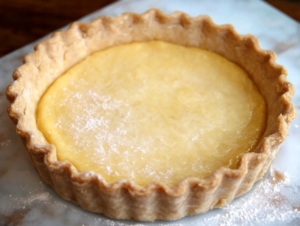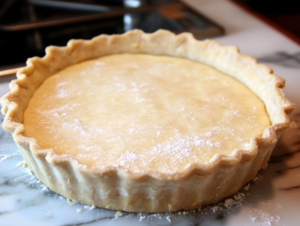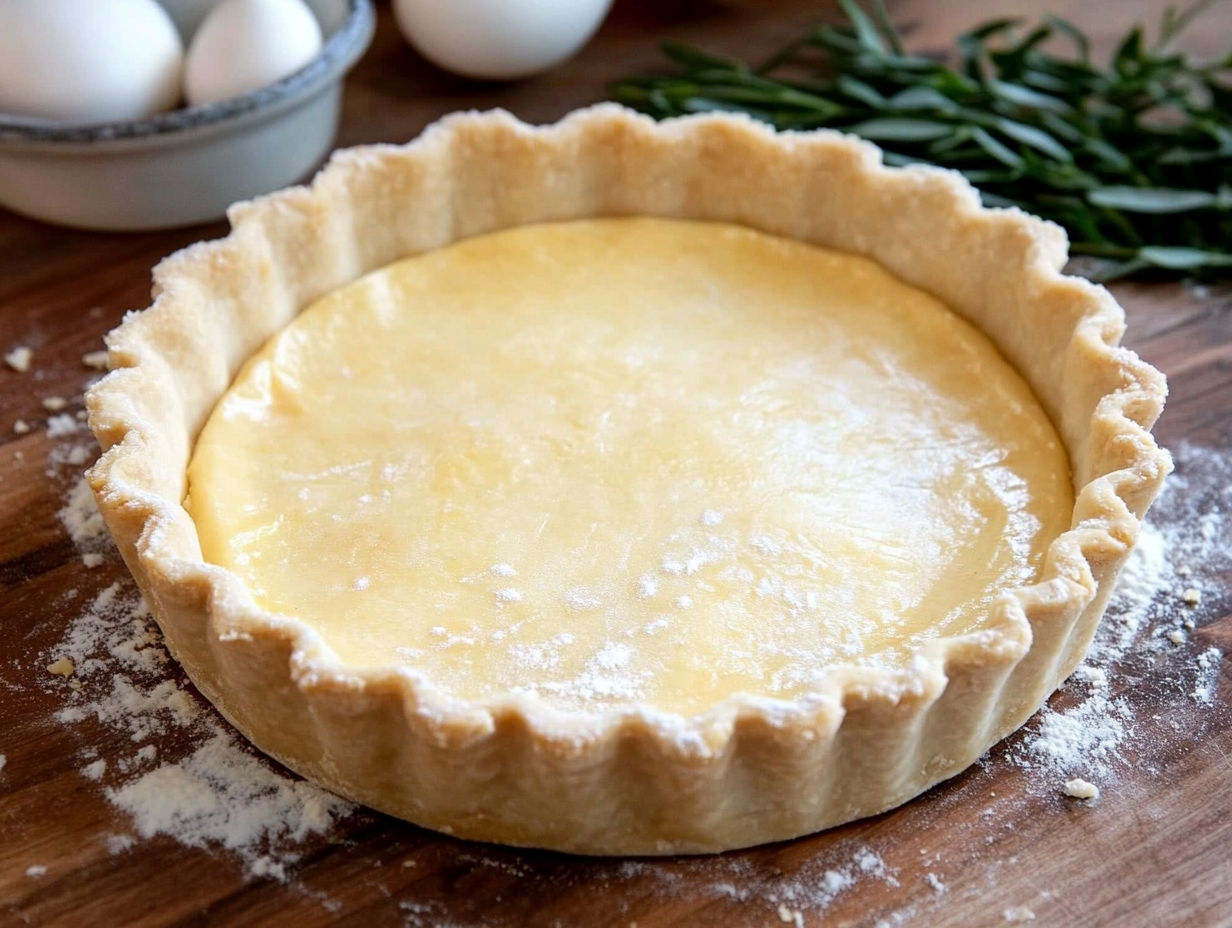A pie crust for quiche serves as the foundation of this savory French-inspired dish, providing a delicate and flavorful base that complements the rich and creamy filling. It is typically a buttery, flaky pastry designed to hold the custard filling without becoming soggy or overpowering its subtle flavors. The crust’s primary role is to encase the filling while maintaining structural integrity during baking and serving, ensuring every bite delivers a perfect balance of texture and taste.
Difference Between Quiche Crust and Regular Pie Crust
Although a quiche crust and a regular pie crust share similar ingredients and techniques, they are crafted with distinct purposes in mind, leading to slight variations:
- Texture:
- Quiche Crust: Designed to be sturdier to hold the liquid custard filling without crumbling or becoming too soft. Often blind-baked to prevent sogginess.
- Regular Pie Crust: Focuses on flakiness and tenderness, as it typically supports firmer fillings like fruits or custards that don’t seep as much liquid.
- Flavor:
- Quiche Crust: May include savory elements such as cheese, herbs, or spices to enhance the quiche’s flavor profile.
- Regular Pie Crust: Maintains a neutral or slightly sweet flavor to complement desserts.
- Technique:
- Quiche Crust: Blind baking (pre-baking) is almost always required to ensure the crust doesn’t become soggy when filled with liquid custard.
- Regular Pie Crust: Blind baking is optional and typically used only for specific fillings.
Essential Ingredients for the Perfect Pie Crust
Flour Types and Their Impact on Texture
The type of flour you use significantly influences the texture of your quiche crust:
- All-Purpose Flour: The most common choice, it balances protein content, resulting in a tender yet sturdy crust.
- Pastry Flour: Lower in protein than all-purpose flour, it produces an extra-light and flaky crust, ideal for quiches where delicacy is preferred.
- Whole Wheat Flour: Adds a nutty flavor and denser texture, suitable for rustic quiches but may require more liquid to achieve the right dough consistency.
Importance of Fat (Butter vs. Shortening)
Fat is the cornerstone of pie crust, impacting both flavor and texture:
- Butter: Delivers rich flavor and flakiness due to its water content, which creates steam during baking. Ideal for a flavorful quiche crust.
- Shortening: Produces a very tender and flaky crust, but lacks the rich flavor of butter. A mix of butter and shortening can combine the best of both.
Role of Salt and Water in Binding the Dough
- Salt: Enhances flavor, subtly balancing the richness of the fat and bringing out the nutty undertones of the flour.
- Water: Cold water is essential to bind the dough together without melting the fat. The right amount ensures a cohesive dough without becoming sticky or tough.
Tools Needed for Making a Pie Crust for Quiche
Rolling Pin: Techniques for Even Dough
A rolling pin is crucial for achieving an even thickness across the dough:
- Techniques: Roll from the center outward, rotating the dough frequently to maintain a circular shape and prevent sticking. Use light, even pressure for uniformity.
- Types: Wooden or marble rolling pins provide stability, while adjustable rolling pins with thickness guides can ensure precision.
Pie Dish or Tart Pan: Which is Better?
The choice between a pie dish and a tart pan depends on your quiche’s style and presentation:
- Pie Dish: Perfect for classic quiches with deeper fillings. The sloped sides help retain the filling and provide a traditional appearance.
- Tart Pan: Ideal for elegant, shallower quiches. The removable bottom allows easy release and attractive presentation.
Mixing Bowls, Parchment Paper, and Bench Scraper Essentials
- Mixing Bowls: Large bowls with wide openings make it easier to combine ingredients without overworking the dough.
- Parchment Paper: Prevents sticking during rolling and can be used for blind baking to hold pie weights.
- Bench Scraper: A versatile tool for cutting butter into flour, lifting dough, and cleaning work surfaces efficiently.

Step-by-Step Guide to Making Pie Crust for Quiche
Preparing the Dough
- Combine Dry Ingredients: Mix flour and salt in a large bowl.
- Cut in the Fat: Add chilled butter (and/or shortening) in small cubes. Use a pastry cutter or your fingers to work the fat into the flour until the mixture resembles coarse crumbs with pea-sized bits of butter.
- Add Cold Water Gradually: Sprinkle in ice-cold water, one tablespoon at a time, mixing gently with a fork or your hands. Stop as soon as the dough holds together when pinched. Overmixing can make the crust tough.
- Shape the Dough: Form the dough into a disk, wrap it in plastic wrap, and prepare it for chilling.
Chilling the Dough for Best Results
- Why Chill? Chilling allows the gluten in the dough to relax, prevents shrinking during baking, and keeps the butter cold, which creates a flakier crust.
- How Long? Refrigerate the dough for at least 30 minutes and up to 2 hours. For longer storage, freeze it and thaw in the fridge before use.
Rolling Out the Dough to the Right Thickness
- Prepare Your Surface: Lightly flour your work surface and rolling pin to prevent sticking.
- Roll Evenly: Start from the center of the dough and roll outward, rotating the dough frequently to maintain a circle. Aim for an even thickness of about 1/8 inch.
- Transfer to the Pan: Carefully drape the rolled-out dough over your rolling pin and lay it into the pie dish or tart pan. Gently press into the corners without stretching the dough to avoid shrinking. Trim any excess dough.
Blind Baking: Why and How
Purpose of Blind Baking for Quiche
Blind baking, or pre-baking, ensures a crisp, fully-cooked crust that won’t become soggy when filled with liquid custard. It also helps maintain the crust’s shape during baking. This step is crucial for quiches, as their fillings are high in moisture.
Methods: Pie Weights vs. Alternative Solutions
- Using Pie Weights:
- Line the dough with parchment paper or aluminum foil, covering the edges to prevent over-browning.
- Fill the crust with pie weights, such as ceramic beads or metal weights, to prevent puffing.
- Alternative Solutions:
- If you don’t have pie weights, dried beans, uncooked rice, or even sugar can work just as well.
- Bake in Two Steps:
- First, bake the weighted crust at 375°F (190°C) for about 15 minutes until the edges are lightly golden.
- Remove the weights and parchment, then bake for another 5-10 minutes to cook the base fully.
Common Mistakes to Avoid
- Skipping the Chill: Always chill the dough before blind baking to minimize shrinking.
- Under-baking: Ensure the crust is golden and dry before adding the filling to prevent sogginess.
- Improper Weight Distribution: Spread weights evenly across the crust to avoid uneven puffing.
- Piercing Holes After Blind Baking: Avoid piercing the dough post-baking, as this can allow liquid filling to seep through.

Common Variations of Pie Crust
Whole Wheat Pie Crust
Whole wheat pie crust adds a nutty, earthy flavor and a more robust texture, making it a healthier alternative to traditional crusts. Here’s how to make it unique:
- Ingredients: Replace part or all of the all-purpose flour with whole wheat flour. You may need to increase the liquid slightly, as whole wheat flour absorbs more moisture.
- Texture: Expect a denser crust compared to one made with all-purpose flour. It pairs well with hearty quiche fillings like spinach, mushrooms, or roasted vegetables.
- Tips: To balance the flavor, consider adding a touch of honey or sugar, especially if using 100% whole wheat flour.
Gluten-Free Pie Crust
For those with dietary restrictions, a gluten-free crust can be just as delicious and flaky:
- Ingredients: Use a gluten-free all-purpose flour blend or a combination of rice flour, almond flour, and tapioca starch. Adding xanthan gum helps bind the dough.
- Technique: Handle the dough gently, as gluten-free flours lack elasticity. Rolling between two sheets of parchment paper can help prevent tearing.
- Filling Pairings: This crust complements lighter quiche fillings, such as cheese and fresh herbs or seafood, as it is often more delicate.
Herb-Infused Crust for Enhanced Flavor
Adding fresh or dried herbs to your crust elevates the flavor and aroma, making it an integral part of the quiche experience:
- Herbs to Use: Parsley, thyme, rosemary, basil, or chives work well. Fresh herbs should be finely chopped, while dried herbs should be used sparingly to avoid overpowering the crust.
- Preparation: Mix the herbs into the dry ingredients before adding the fat. This ensures even distribution throughout the dough.
- Flavor Pairings: Herb-infused crusts are perfect for quiches with vegetable-based fillings or Mediterranean-inspired ingredients like sun-dried tomatoes, olives, and feta.
Frequently Asked Questions About Pie Crust for Quiche
Can I Use Store-Bought Pie Crust for Quiche?
Yes, store-bought pie crust can be a convenient option for quiche, especially when short on time. However, there are a few considerations:
- Types of Crust: Look for a high-quality, all-butter crust or a frozen pastry crust designed for savory dishes. Avoid sweetened crusts, as they can clash with the quiche filling.
- Preparation: Even with a store-bought crust, blind baking is essential to prevent sogginess. Follow the package instructions for pre-baking, or bake at 375°F (190°C) for 10-15 minutes before adding the filling.
- Customization: To enhance flavor, you can brush the crust with an egg wash or sprinkle herbs or grated cheese before blind baking.
How Do I Make Pie Crust More Flavorful?
To elevate the taste of your pie crust, consider these enhancements:
- Add Cheese: Mix grated Parmesan, cheddar, or Gruyère into the dry ingredients for a cheesy, savory crust.
- Incorporate Herbs or Spices: Add finely chopped fresh herbs like thyme or parsley, or spices like smoked paprika or black pepper, to the dough for a burst of flavor.
- Use High-Quality Fat: Butter or a combination of butter and lard/shortening with rich, creamy flavors can make a significant difference.
- Finish with a Wash: Brush the crust with an egg wash (beaten egg with a splash of water) or milk before baking to achieve a golden, glossy finish and enhanced flavor.
What Type of Butter Works Best for Quiche Crust?
The type of butter you choose can influence both the flavor and texture of the crust:
- Unsalted Butter: Preferred for better control of salt in the recipe. Its pure, rich flavor complements the savory custard filling.
- High-Fat European Butter: Contains a higher butterfat percentage, resulting in a more tender, flaky crust and a deeper, creamier flavor.
- Cold Butter: Regardless of the type, butter should be very cold to ensure it creates steam pockets during baking, which leads to flakiness.
- Direct readers to the Bisquick Quiche Recipe for a quick and easy alternative quiche preparation.
- Suggest the Quiche Dough Recipe for those interested in learning more about preparing the dough itself.
- Link to the Veggie Quiche Recipe to inspire readers with a healthy, vegetable-focused quiche.
- Highlight the Yogurt Pie as an example of another recipe where a versatile pie crust can shine.
- Include the Pizza Pie link to show how similar techniques apply to other savory pie recipes.
Conclusion
Mastering the art of crafting a perfect pie crust for quiche is a rewarding endeavor that elevates this savory dish to new heights. From understanding the essential ingredients and tools to employing techniques like blind baking, each step plays a vital role in achieving a flavorful and structurally sound crust. By experimenting with variations such as whole wheat, gluten-free, or herb-infused crusts, you can tailor the recipe to suit different tastes and dietary preferences. Whether you opt for a classic or creative approach, the foundation of your quiche will always shine with a well-made crust.

